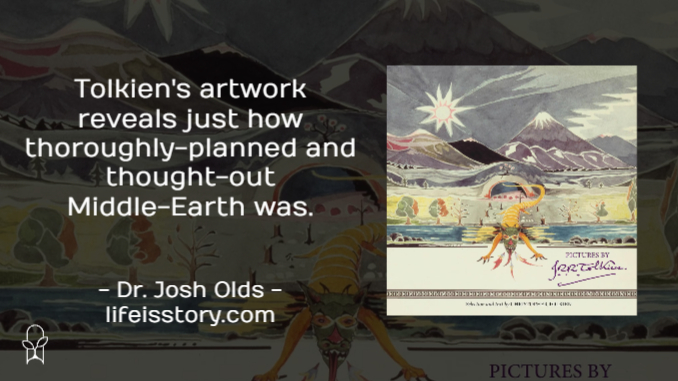
Also by this author: The Battle of Maldon: Together with the Homecoming of Beorhtnoth, The History of the Hobbit, The Lay of Aotrou and Itroun, The Story Of Kullervo
Published by HarperCollins on November 11, 2021
Buy on Amazon
Goodreads

With Christopher Tolkien as your guide, take a tour through this colourful gallery of enchanting art produced by J.R.R. Tolkien and presented in an elegant new slipcased edition.
This collection of pictures, with a text by Christopher Tolkien, now reissued after almost 30 years confirms J.R.R. Tolkien’s considerable talent as an artist. It provides fascinating insight into his visual conception of many of the places and events familiar to readers of The Hobbit, The Lord of the Rings and The Silmarillion.
Examples of his art range from delicate watercolours depicting Rivendell, the Forest of Lothlorien, Smaug, and Old Man Willow, to drawings and sketches of Moria Gate and Minas Tirith. Together they form a comprehensive collection of Tolkien’s own illustrations for his most popular books.
Also included are many of his beautiful designs showing patterns of flowers and trees, friezes, tapestries and heraldic devices associated with the world of Middle-earth. In their variety and scope they provide abundant visual evidence of the richness of his imagination.
This enchanting gallery was personally selected by Christopher Tolkien who, through detailed notes on the sources for each picture, provides unique insight into the artistic vision of his father, J.R.R. Tolkien.
JRR Tolkien was not only a writer, but he loved to illustrate as well. From 1973-1979 (with a gap in 1975), a series of calendars were published that used Tolkien’s paintings, drawings, and designs. 1973 was published in the United States by Ballantine and 1974, 1976-1979 were published in the UK by George Allen and Unwin. The first two were published during Tolkien’s lifetime and approved by him with the latter four coming after his passing and serving as a unique homage to the man whose literary life had influenced so many.
1973 and 1974, having been for different audiences contained much of the same material. 1976 was called The Hobbit Calendar and focused on images from The Hobbit; 1977 focused on The Lord of the Rings; 1978 on the Silmarillion; and the final calendar in 1979 was called the JRR Tolkien Calendar and consisted of a smattering of previously unpublished work. After the release of that final calendar, the images from all the calendars were compiled along with some other unpublished Tolkien pictures into book form. Christopher Tolkien wrote that this book, entitled Pictures, “nearly approached completeness.”
A second edition was published in 1992 with some changes and updates. This was then reissued in 2021. While the newest reissue is substantively the same, the quality is greatly improved. Modern technology allowed for digital scans of the originals to be made, making the reprinted images higher resolution, better quality, and more exact in its color reproduction. The deluxe edition also comes with a slipcase cover that protects the book. (And please note that the dragon on the cover is NOT Smaug, but the much older Glaurung, Father of Dragons.) It’s a beautiful coffee table book for fans of Tolkien.
Each picture is accompanied by explanatory text from Christopher Tolkien. As beautiful as the pictures are, it’s even better to see and understand their history. The pictures range from completed works that featured in Tolkien’s books to unfinished sketches—one of Rivendell done in crayon!—that gives us insight into Tolkien’s creative processes and allows us as readers to envision the world the way Tolkien did.
Many of the works that were included in the calendars were colorized by artist H.E. Riddett. In those cases, Christopher Tolkien includes both the colorized versions and his father’s original black and white renditions. Perhaps my favorite image is no. 28 “Shelob’s Lair.” The image is of mountain pass to Cirith Ungol, but is incorporated into a handwritten draft page of the text. There’s something magical about reading the story in Tolkien’s handwriting.
I also like that Tolkien’s doodles are included. Literally, drawings of patterns on newspaper that Christopher Tolkien says his father would draw while contemplating the crossword puzzle. It shows how much art was part of Tolkien’s life and how it was done for his own pleasure and sense of creativity and not for commercial gain.
I love Pictures for the insight it gives us into Tolkien’s mind and his sub-creative world. From narrative to poetry to songs to paintings and drawings, Tolkien’s creativity that he poured into Middle-earth was well-rounded and comprehensive, which is part of why I think his world has endured and is still so beloved today.
